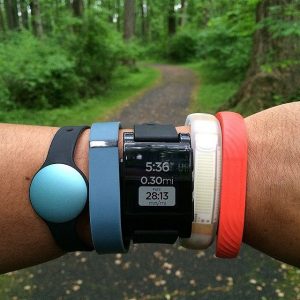 Raise your wrist if you received a wearable activity tracker (aka Fitbit, Apple Watch, or Garmin Vivosmart) for Christmas.
Raise your wrist if you received a wearable activity tracker (aka Fitbit, Apple Watch, or Garmin Vivosmart) for Christmas.
Raise your wrist if you own one already.
You are one of a growing number of Americans (more than 20%) who look for health-minded ways to quantify yourself. You know the steps you take, the heart rate you have, the minutes you stand, the hours you sleep, and the calories you burn.
For the most part, this is a very good thing. But it’s only good as long as you keep checking in.
According to Dr. Brian Rider, assistant professor of kinesiology and director of the department’s Health Dynamics program, most adults who own a wearable activity tracker are delighted and diligent with their device but only for a while. About one third of owners stop using their fitness tracker after six months, and more than half eventually abandon them altogether (wired.com).
“There is evidence to support that the initial push that we get from monitoring how active we are does help us to become more active,” explains Rider, whose research interest include the use of activity monitors to measure and promote physical activity. “It’s not super long lasting. There’s a bit of a plateau.”
If one of your New Year’s resolutions is to start and maintain your fitness tracking, how then do you continue to find the motivation to strap on your activity tracker and move everyday, all year?
Rider says it’s best to couple your new-fangled exercise technology with old- fashioned pencil and paper.

“Researchers have found that wearable fitness technology is effective, if (1) an activity goal, either in steps or calories burned, is articulated, and then (2) you actually have a place to write that down,” says Rider. “I think a lot of times people offload the responsibilities of daily tracking by saying, ‘Oh, the device tracks all that for me’ and they forget to even go and look at it. But research has shown if you actually write down what you get at the end of each day, it’s more a constant reminder whether you achieved your goal or not.”
“People get the idea that they’ve got to do 10,000 steps because they heard it on the news or at work,” Rider continues. “And if they’re not able to reach that goal, they became very discouraged and stop using the device.”
What is a good goal for you to set though? That depends, of course, on several factors like age, current activity level, and your overall health composition. Though the buzz around fitness trackers is the 10,000 step mark, for many people, that’s just not realistic, says Rider.
“People get the idea that they’ve got to do 10,000 steps because they heard it on the news or at work,” Rider continues. “And if they’re not able to reach that goal, they became very discouraged and stop using the device when really, 10,000 steps, which is roughly five miles per day, is not realistic to tell everyone.”
Instead, Rider explains, many people can add on extra steps in their day by just parking further away from the store or office, using the restroom on the next floor, or taking a walking break every hour for a couple minutes. “The daily little things add up,” he says. “And people were amazed how quickly they accrue extra steps by doing those little things.”
“Researchers have found that wearable fitness technology is effective, if (1) an activity goal, either in steps or calories burned, is articulated, and then (2) you actually have a place to write that down,” says Rider.
In a weight-loss intervention study that Rider conducted while in his doctoral program at the University of Tennessee, he and other researchers based participants’ step goals on how much they were currently active. First, they wore an activity tracker for one week to gage their average normal activity in steps.
“Then we asked them to take another 1,000 steps a day for a week, then another 1,000 the next week, and we capped them at 3,000 more steps so they added roughly a mile more than they were normally walking after a month in the study,” Rider explains. “That seemed to work pretty well for them and kept them going.”
Want to learn more about Rider’s research?
Rider plans to discuss his research on wearable fitness trackers further at an upcoming presentation during Hope’s Winter Happening on Saturday, Jan. 20. He joins five other Hope faculty who will share their academic wisdom with the Hope community. Registration is open now.


Enjoyed the article. I run our corporate staff wellness program in the public schools and still insist on some type of goal setting, tracking system on paper or using an existing google document. It was nice to share this article with staff to help support the continued use of those tools. Thank you!